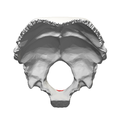Foramen magnum: Difference between revisions
From WikiMD's Wellness Encyclopedia
No edit summary |
CSV import Tags: mobile edit mobile web edit |
||
| Line 31: | Line 31: | ||
[[Category:Skull]] | [[Category:Skull]] | ||
[[Category:Neuroanatomy]] | [[Category:Neuroanatomy]] | ||
==Foramen magnum== | |||
<gallery> | |||
File:Crane4_Foramen_magnum.png|Foramen magnum | |||
File:Gray130.png|Base of the skull | |||
File:Medulla_oblongata_and_foramen_magnum_animation_small.gif|Medulla oblongata and foramen magnum | |||
File:Occipital_bone_Opisthion01.png|Occipital bone Opisthion | |||
File:Occipital_bone_Basion05.png|Occipital bone Basion | |||
</gallery> | |||
Latest revision as of 04:57, 18 February 2025
The foramen magnum (Latin for "great hole") is a large oval-shaped opening located in the base of the occipital bone. It represents a vital anatomical structure as it allows for the passage of the spinal cord from the brainstem to the spinal column. Notably, it is the largest foramen in the skull.
Anatomy[edit]
- Location: Situated centrally at the base of the skull, bordered anteriorly by the basiocciput, posteriorly by the supraoccipital, and laterally by the exoccipitals.
- Size and Shape: Oval in outline, its longest diameter is anteroposterior, with variations in its dimensions among individuals.
- Structures Passing Through: The foramen magnum transmits various important structures:
- The lower part of the medulla oblongata, which continues as the spinal cord.
- The vertebral arteries, which ascend to supply the brain.
- The anterior and posterior spinal arteries.
- The meningeal branches of the vertebral arteries.
- The spinal accessory nerve (cranial nerve XI).
Clinical Significance[edit]
- Trauma: Fractures involving the foramen magnum are rare due to its protected location, but when they occur, they can be life-threatening due to the potential for neural damage.
- Tumors: Masses near the foramen magnum can compress the medulla or upper spinal cord, leading to neurological deficits.
- Chiari Malformation: A congenital condition where part of the cerebellum protrudes through the foramen magnum into the cervical spinal canal. Symptoms may include headaches, balance problems, and muscle weakness.
- Measurements: The size and shape of the foramen magnum are sometimes studied in anthropological and forensic contexts, as they can provide information about locomotion and posture in extinct hominins and help in identification processes.
Comparative Anatomy[edit]
In various animals, the position and size of the foramen magnum can provide insights into their mode of locomotion and posture. In bipedal organisms like humans, the foramen magnum is more anteriorly positioned, suggesting an upright posture. In quadrupedal animals, it is more posteriorly placed.







